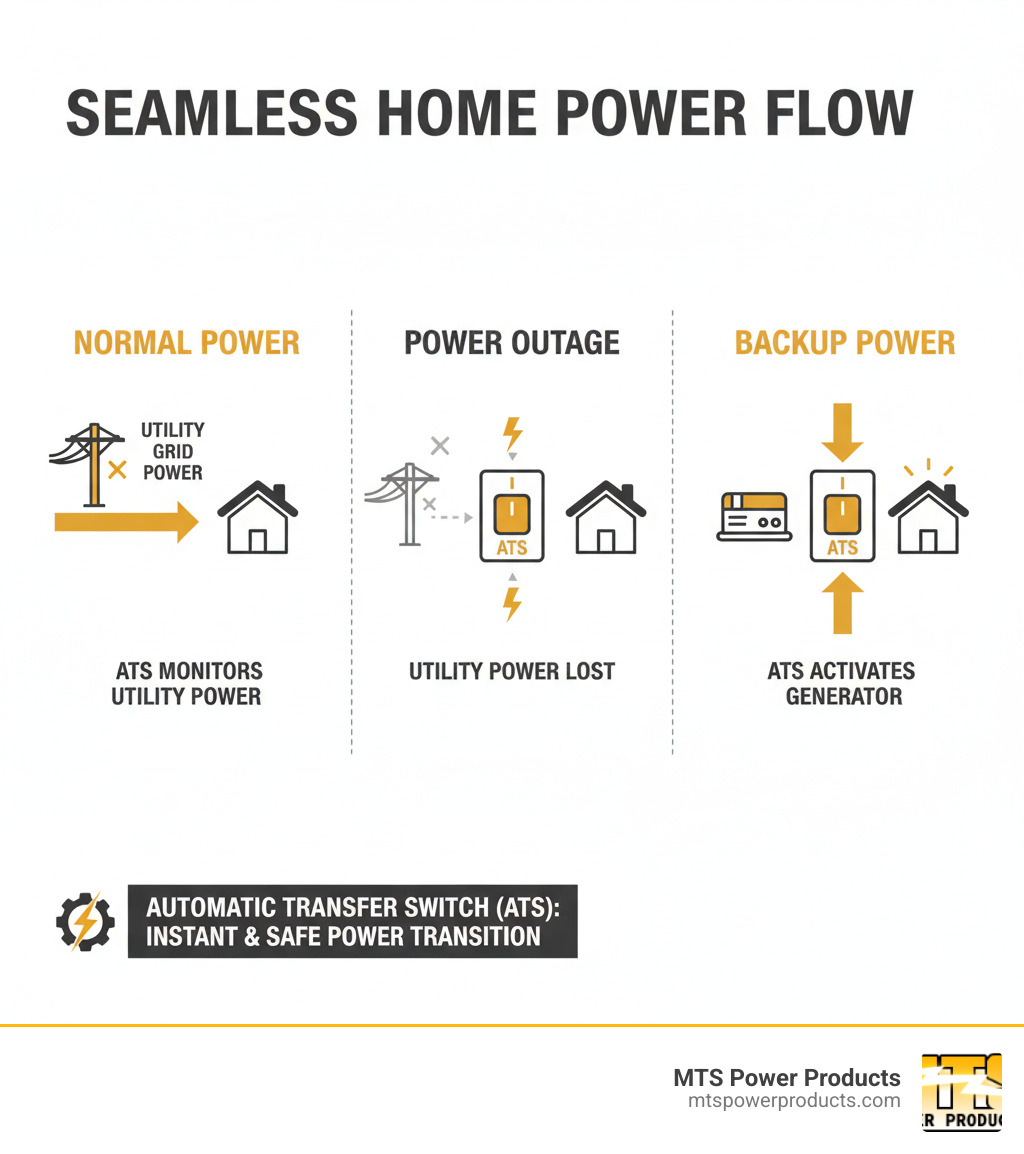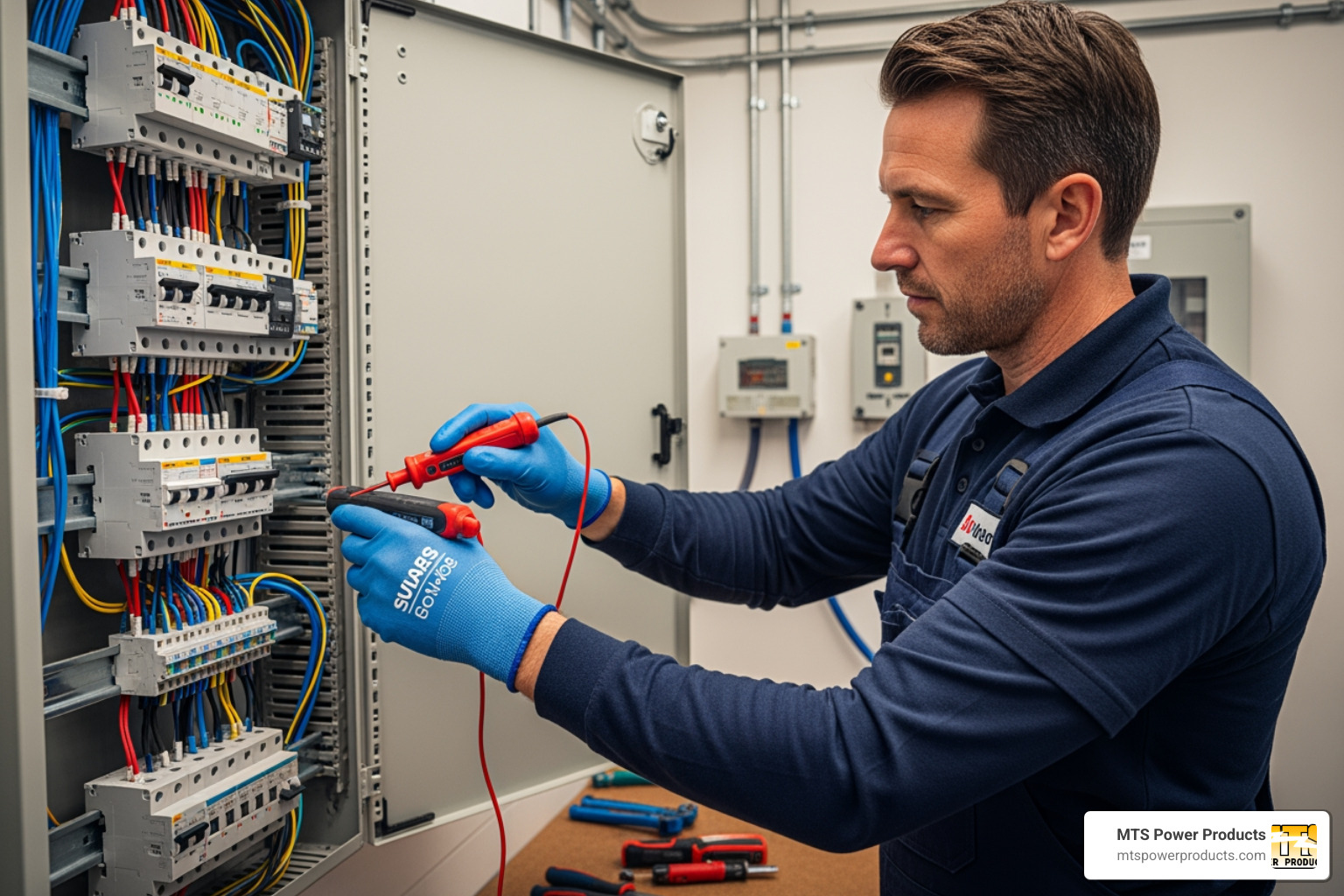
Buy Direct
from the Manufacturer
Sell our Products
Become a Distributor
Discounts
on volume purchases
Visit Us
at our Miami office
from the Manufacturer
Become a Distributor
on volume purchases
at our Miami office
How to setup automatic transfer switch for generators involves mounting the ATS near your main electrical panel, connecting utility and generator power lines, wiring load circuits, and testing the system. A professional installation typically takes 4-6 hours and costs between $350-$2,000, depending on the switch type.
Quick Setup Overview:
Power outages are more than an inconvenience; they can be costly and dangerous. Manually connecting a generator during an emergency is risky, and improper connections can injure utility workers or damage your equipment through backfeeding.
An Automatic Transfer Switch (ATS) is the solution. It constantly monitors your utility power and automatically switches to your generator when an outage occurs. No manual effort, no safety risks—just seamless, reliable backup power to keep your home or business running.
Whether you’re protecting your family or ensuring business continuity, a properly installed ATS is essential for safety, compliance, and peace of mind.

Related content about how to setup automatic transfer switch for generators:
An Automatic Transfer Switch (ATS) acts as your property’s electrical guardian, constantly monitoring the power supply to ensure you have electricity. Its sole purpose is to switch to backup power the moment the utility grid fails.
Here’s how it works: The ATS monitors the incoming utility power’s voltage and frequency. If it detects a problem like a blackout or voltage sag, it initiates an automatic load transfer. The ATS signals your generator to start. Once the generator provides stable power, the ATS disconnects your building from the utility line and connects it to the generator. When utility power is restored and stable, the process reverses automatically. The entire sequence happens without any manual intervention.
This automated process is a critical safety feature, as it prevents backfeeding—the dangerous flow of generator power back into utility lines. Understanding this mechanism is a key part of learning how to setup automatic transfer switch for generators.
For a comprehensive look at these devices, see our Automatic Transfer Switch (ATS) – Complete Guide.
Your main choice in backup power is between a manual or automatic switch.
A manual transfer switch requires you to start your generator and physically flip switches to power selected circuits. It’s a hands-on, lower-cost solution, with units typically costing $250-$400. This option is practical if you’re home during an outage and using a portable generator.
An automatic transfer switch does everything for you. It detects an outage, starts your standby generator, and transfers the load automatically, providing seamless power whether you’re home or away. The convenience and speed come at a higher cost, with units starting around $1,000. Automatic switches are the standard for permanent standby generators, where uninterrupted power is critical.
Installation complexity also differs. Manual switches involve simpler wiring, while automatic systems require control wiring to the generator and power-sensing circuits. Your choice depends on your budget, convenience needs, and how critical continuous power is for your situation.
Explore your options in our guide on Generator Transfer Switch Options.
Automatic transfer switches come in several varieties to suit different needs.
At MTS Power Products, our Automatic Transfer Switch Controls offer sophisticated features for managing any power switching scenario.
Proper planning, budgeting, and a focus on safety are critical before starting an ATS installation. While the DIY approach is tempting, how to setup automatic transfer switch for generators is a job for a licensed electrician. Working with your home’s main electrical panel involves high voltage and significant risks. A professional ensures the installation is safe and compliant with the National Electrical Code (NEC) and local regulations, and they will handle the required permits and inspections.
Let’s talk numbers. A manual transfer switch kit may cost $250 to $400. An automatic transfer switch unit typically starts around $1,000. With professional installation, the total cost for an automatic system is often around $2,000, but this can vary based on your home’s electrical system and the complexity of the job. This investment buys you a safe, reliable, and code-compliant system.
For a detailed cost breakdown, see our article on How Much Does an Automatic Transfer Switch Cost? and compare estimates from resources like HomeAdvisor.
Working with your main electrical panel can be fatal. There is no room for error. The following safety measures are non-negotiable.

While your electrician will provide the necessary equipment, it’s helpful to know what’s involved. The installation requires specialized tools like voltage testers, wire strippers, conduit benders, and a torque wrench to ensure connections are tightened to manufacturer specifications.
Key materials include:
As mentioned, expect a typical professional installation to cost around $2,000. The final price depends on your specific setup, local labor rates, and the number of circuits you’re backing up.
This section outlines the general process for how to setup automatic transfer switch for generators. This is a complex electrical project that should only be performed by a licensed professional electrician. Always follow the manufacturer’s manual and all local electrical codes.
The first step is choosing a location. The ATS is typically mounted vertically near your main electrical panel to keep wiring runs short. Outdoor installations require a NEMA 3R rated enclosure to protect against rain and weather, a must-have in South Florida.
For context, a manual switch installation is more straightforward. After shutting off the main power, an electrician mounts the switch panel next to your main panel. They wire the essential circuits you want to power from your main panel to the transfer switch. An outdoor power inlet box is installed and connected to the transfer switch. During an outage, you manually start your generator, plug it in, and flip the switches from “Line” to “Generator.”
An automatic installation is more sophisticated due to its sensing and control systems. Depending on your needs, an ATS can be installed as a service entrance device to provide whole-home backup or as a sub-panel to power only selected critical circuits.
Here is a general overview of the professional installation process:
Safety First: The electrician will disconnect all power at the main utility service and use a voltage tester to confirm all circuits are de-energized.
Mount the ATS: The enclosure is securely mounted to a solid structure, ensuring it is level and accessible for future maintenance.
Connect Utility Power: The incoming utility power lines are wired to the ATS. This allows the switch to monitor the grid and detect an outage.
Wire Generator Power and Controls: Heavy-gauge cable is run from the standby generator to the ATS. Critically, smaller control wires are also connected, creating the communication link that allows the ATS to automatically start and stop the generator.
Connect Load Circuits: Your home’s circuits are connected to the ATS. This may involve installing new breakers in an integrated load center or re-routing circuits, depending on the ATS model.
Install Load Management Modules: If your system includes devices like Smart A/C Modules (SACM) or Smart Management Modules (SMM), the electrician will wire them to prevent generator overload by shedding non-essential loads automatically.
Finalize Connections: All connections are tightened to the factory-specified torque to prevent hazardous arcing. A Fault Current Identification Label is applied to the enclosure to meet code requirements.
A standard residential installation typically takes a professional four to six hours. The result is a fully automated system that protects your home during an outage. For more technical details, see our Install Generator ATS Complete Guide.
Once the installation is complete, the final phase is commissioning and testing. This dress rehearsal ensures your ATS will perform flawlessly during a real power outage.
The commissioning process involves a methodical validation of the entire system by simulating a power failure. This confirms that the steps for how to setup automatic transfer switch for generators were performed correctly.

Your electrician will perform several critical tests:
Modern ATS technology offers remarkable flexibility for specialized applications.
The intelligence behind these systems comes from advanced ATS controllers. Our McPherson Controls line, available at our Automatic Transfer Switch Controls page, provides the sophisticated logic needed to manage complex power scenarios safely and reliably.
Here are answers to some of the most common questions we receive from customers in Miami about automatic transfer switch installation.
Yes. In almost all jurisdictions, you need both utility approval and a local building permit before installing an ATS. This is a critical safety measure. Your utility has specific requirements for equipment and connection procedures, and your local municipality requires a permit and inspection to ensure the installation meets all electrical codes. A licensed electrician will manage this entire process, from submitting plans to coordinating with the utility for any required meter pull and scheduling the final inspection.
Yes, and it is highly recommended. A Surge Protection Device (SPD) can be installed at your main service panel to safeguard your ATS, generator, and all the sensitive electronics in your home from power surges. Surges can come from lightning, grid fluctuations, or even large appliances cycling. Many modern ATS units come with built-in surge protection, but if yours doesn’t, adding one is a smart investment in protecting your entire electrical system.
Regular maintenance ensures your ATS is ready when you need it. Follow this simple schedule:
Don’t forget to perform regular generator maintenance as well. A well-maintained generator and ATS form a reliable team.
Understanding how to setup automatic transfer switch for generators empowers you to protect your home or business from power outages. It’s an investment in safety, convenience, and the peace of mind that comes from knowing your critical systems are secure.
We’ve covered the fundamentals, from what an ATS does to the importance of professional installation. In a place like Miami, FL, where severe weather is a constant threat, a properly installed ATS is not a luxury—it’s essential. The true value is the seamless, automatic protection it provides, keeping your lights on and your home comfortable without you lifting a finger.
At MTS Power Products, we specialize in helping South Florida residents and businesses achieve power independence. Our high-quality automatic transfer switches are built for reliability, and our McPherson Controls line offers advanced features for complete control over your backup power system.
Located minutes from the Miami International Airport and the Port of Miami, we provide expert support and worldwide delivery. Whether you need a simple manual switch or a sophisticated whole-home ATS, we have the expertise to meet your needs.
Don’t wait for the next storm warning. The time to prepare is now.
Find the perfect Generator Automatic Transfer Switch for your needs
